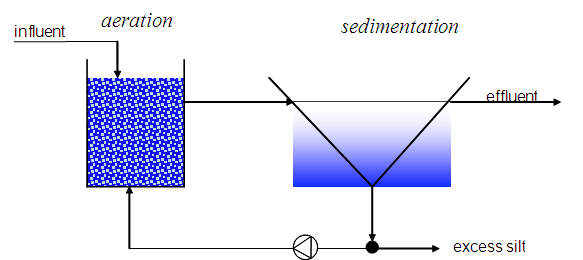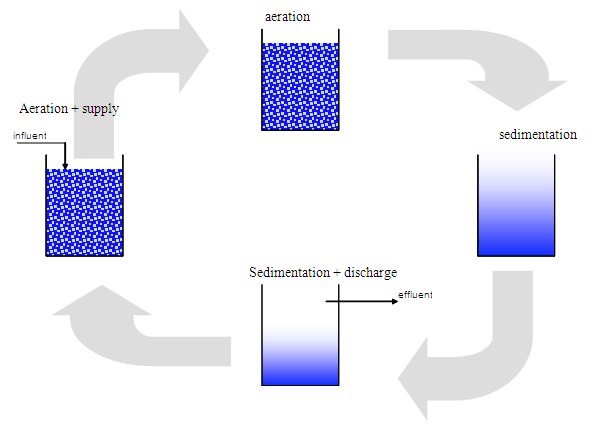Method diagram
Method diagram 1: Conventional system

Method diagram 2: SBR type

Method and installation description
Aerobic water purification based on biological oxidation with active sludge is primarily used to remove organic fraction from waste water. In addition to the removal of organic substances, this purification method is also able to eliminate nitrogen and phosphorus, though to a lesser extent.
Sludge floccules contain aerobic micro-organisms. This active sludge is a mix of microscopic organisms: bacteria, protozoa, rotifers[1], etc. If sufficient oxygen is present, these organisms are able to oxidise organic components in the wastewater (influent) into CO2 and water. This process is referred to as dissimilation.
However, part of the organic material is used to create new biomass. This is referred to as assimilation. The rising sludge concentration can be controlled by regularly removing the biomass from the system. However, if an aerobic purification system is only operated at a very low load, there will often be low sludge growth.
The reaction for the oxidation of organic matter can be explained as follows:
wastewater + biomass + O2 -> CO2 + H2O + new biomass
Types of implementation
Conventional active sludge system
A conventional active sludge system consists of an aeration tank, which is used for biological degradation, and a sedimentation tank, where the sludge in separated from the treated wastewater (see method diagram 1). Sludge floccules with a good structure and high density are recommended in order to successfully complete this step. The aeration basins are sometimes preceded by a mixing tank (selector), where the influent is intensively mixed with sludge. The aim of this is to prevent the growth of thread-forming bacteria. A conventional active sludge system is generally more successful in realising sedimentation, compared to an SBR, due to the specific function of the sedimentation tank (conical in shape, featuring a scraper).
SBR (Sequencing Batch Reactor)
In an SBR (see method diagram 2), the various purification processes are performed consecutively in the same basins. A standard cycle involves filling, aeration, sedimentation and drainage. An SBR is thus perfectly suited to waste flows that are released in batches. A buffer must be implemented for continuous waste flows. An SBR can be used to consecutively perform various biological processes, like nitrification and denitrification. These process times are flexible and can be easily modified (e.g. longer sedimentation time for slit that does not settle easily). An SBR system is better at preventing thread-forming bacteria because the system acts as a selector during the supply phase.
Membrane bio-reactors
In membrane bio-reactors, the sedimentation step is replaced by membrane separation.
Specific advantages and disadvantages
Active sludge systems are flexible, robust and cost-effective. A wide range of influent concentrations can be treated. An active sludge system is flexible and is able to realise effective purification in influents that vary little in terms of composition or supply. For wastewater that varies greatly in concentration or volume, a buffer tank is needed to control these peaks. An active sludge tank is a fairly simple device but requires the main process parameters (sedimentation, load, etc.) to be supervised and followed-up on a regular basis. In most cases, the process set-up can be greatly optimised.
The system requires limited maintenance, partly because mechanical components like sludge scrapers and borers are not needed in small systems.
Wastewater must react effectively to biological degradation if an active sludge tank is going to be implemented. Biological degradation can be tested at laboratory level. A disadvantage of the active sludge tank is that it requires a relatively large system due to long retention times in the tank, the relatively low sludge content and the large sedimentation surface. The other main disadvantages, primarily in comparison with anaerobic treatment, are the high cost of energy and the processing and disposal of sludge.
Application
Active sludge tanks are implemented on a large scale for industrial and domestic wastewater with organic pollutants.
Boundary conditions
The temperature of wastewater is normally between 15 and 35°C. A wide range of COD values can be treated. Highly acidic or alkaline waters must be corrected so that a pH between 6.5 and 8.5 can be implemented within the system. In order to optimise the growth of micro-organisms, it is important for the wastewater to be biologically degradable and contain a suitable ratio of organic carbon/nitrogen/phosphorous (C/N/P). This ratio is often expressed as the BOD/N/P ratio, which must ideally amount to 100/5/1. N and P must be added in some cases. Active sludge systems are relatively insensitive, but can be inhibited by high concentrations of salts and specific chemicals.
Effectiveness
The BOD is largely removed by such biological systems. The yield for COD is determined by the biological degradation of the water.
Support aids
It may be necessary to add nutrients like phosphorous and urea in order to realise the required C/N/P ratio. As a rule of thumb, BOD/N/P = 100/5/1. It may also be necessary to correct the pH of the influent using lye or acid. Sometimes, pH correction is also implemented directly in the active sludge tank.
In a number of cases it is necessary to add very low concentrations of micro-nutrients like Na, Ca, Mg, Zn, Cu and/or B to optimise the effectiveness of the biological processes. This is normally implemented in wastewater with a unilateral composition.
Environmental issues
Sludge is released as by-product. Depending on the influent, the location and the system, it may be necessary to take measures against odour problems, the emission of harmful substances and aerosols into the air, and noise problems.
Costs
The investment cost is determined by the size of the system.
case 1: Food industry (2008)
The investment cost for an SBR for the treatment of 30 m³/day with a COD concentration of 5000 mg/l, including buffer tank of 100 m³ with pH correction, nutrient creation and dosage, amounts to € 250.000.
case 2: Food industry (2008)
For the treatment of 1600 m³/day of wastewater with 1500 mg/l COD, the investment cost for a conventional active sludge system amounts to € 950.000, including sludge storage and service building.
The following rules of thumb apply to annual operational costs. Maintenance amounts to approximately 2% of the investment cost. Energy consumption amounts to circa 0.1 kWh per i.e., Labour time for operation is circa 1 day per week for systems smaller than 1000 i.e., circa 2 days per week for systems smaller than 4000 i.e. and more than 3 days per week for systems larger than 5000 i.e.
Comments
none
Complexity
The active sludge process is relatively simple and can operate automatically in many cases. However, frequent manual follow-up is needed to evaluate and possibly modify the purification process.
Level of automation
Aerobic biological wastewater purification systems offer a great deal of automation. Analysis results must be used to optimise process management.
References
- Baeyens J., Hosten L. and Van Vaerenbergh E., Wastewater purification, Environment Foundation - Kluwer Editorial, 1995
- EIPPCB, Reference Document on BAT in Common Waste Water and Waste Gas Treatment / Management Systems in the Chemical Sector, draft February 2009 (revision upon release)
- Koot A.C.J., Treatment of wastewater, Waltman Publishers, Delft (NL), 1980
- Stowa, The active sludge process – possibilities and limitations, 2007
- VITO-SCT, revision of technical notes WASS, 2009
[1] Rotifers or radar animals are relatively large, clearly mobile, long, multi-cell organisms. Primarily found in low-load systems.
Version February 2010

